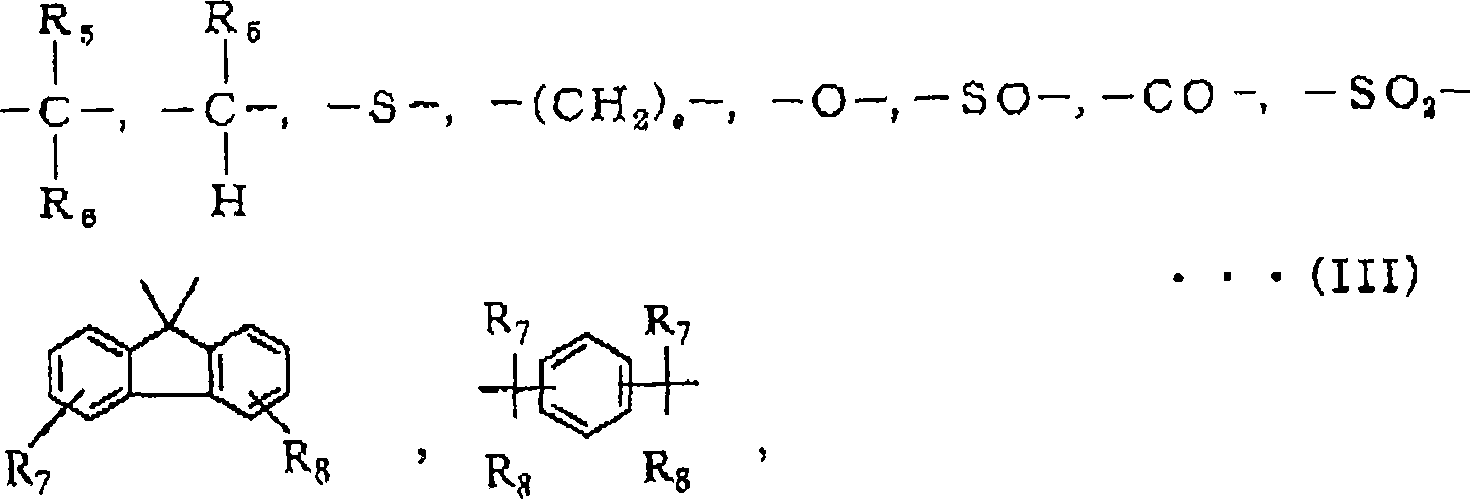Polycarbonate resin and optical material comprising the same
A polycarbonate resin and carbon atom technology, applied in the field of polycarbonate resin and optical materials using the resin, can solve problems such as no introduction and the like
- Summary
- Abstract
- Description
- Claims
- Application Information
AI Technical Summary
Problems solved by technology
Method used
Image
Examples
Embodiment 1
[0104] In 52 liters of a 7.9% (w / w) sodium hydroxide aqueous solution, 20 g of bisulphate and 7.00 kg of 2,2-bis(4-hydroxyphenyl)propane (hereinafter abbreviated as BPA) were added and dissolved. 32 liters of dichloromethane was added thereto, stirring was maintained at 15°C, and 3.67 kg of phosgene was blown in at a rate of 0.12 kg / min.
[0105] Dissolve dodecyl-4-hydroxybenzoate (manufactured by API Corporation, trade name: POB-C12, hereinafter referred to as POB-C12) as a terminal terminator in 3 liters of dichloromethane kept at 35°C. 620g of the solution was added to the above-mentioned solution after the blowing of phosgene was terminated, stirred vigorously for 10 minutes, then added 12ml of triethylamine, and stirred for about 1 hour to polymerize.
[0106] Add 10 liters of dichloromethane to the polymerization liquid, stir for 5 minutes, separate the water phase and the organic phase, neutralize the organic phase with phosphoric acid, and wash repeatedly to make the c...
Embodiment 2
[0114] Except that the 579g terminal terminator POB-C12 used was changed to stearoyl-4-hydroxybenzoate (manufactured by API Corporation, trade name: POB-C18, hereinafter referred to as POB-C18) 790g, and the implementation Example 1 is also operated.
[0115] The intrinsic viscosity [η] of the obtained polymer was 0.35 dl / g, and the polymer was analyzed by infrared absorption spectroscopic analysis, and it was confirmed that it had a polycarbonate polymer structure equivalent to that of Example 1 except for the terminal structure. As in Example 1, the evaluation results are shown in Table 1.
[0116] It can be seen from Table 1 that for the polycarbonate described in Example 1 and Example 2, at a temperature of 25° C. and a relative humidity of 80% RH to 45% RH, the rate of change of the coefficient of water expansion is below 3.5 ppm / % RH. The rate of change in the water expansion rate due to changes in humidity is small.
PUM
 Login to View More
Login to View More Abstract
Description
Claims
Application Information
 Login to View More
Login to View More - R&D
- Intellectual Property
- Life Sciences
- Materials
- Tech Scout
- Unparalleled Data Quality
- Higher Quality Content
- 60% Fewer Hallucinations
Browse by: Latest US Patents, China's latest patents, Technical Efficacy Thesaurus, Application Domain, Technology Topic, Popular Technical Reports.
© 2025 PatSnap. All rights reserved.Legal|Privacy policy|Modern Slavery Act Transparency Statement|Sitemap|About US| Contact US: help@patsnap.com



